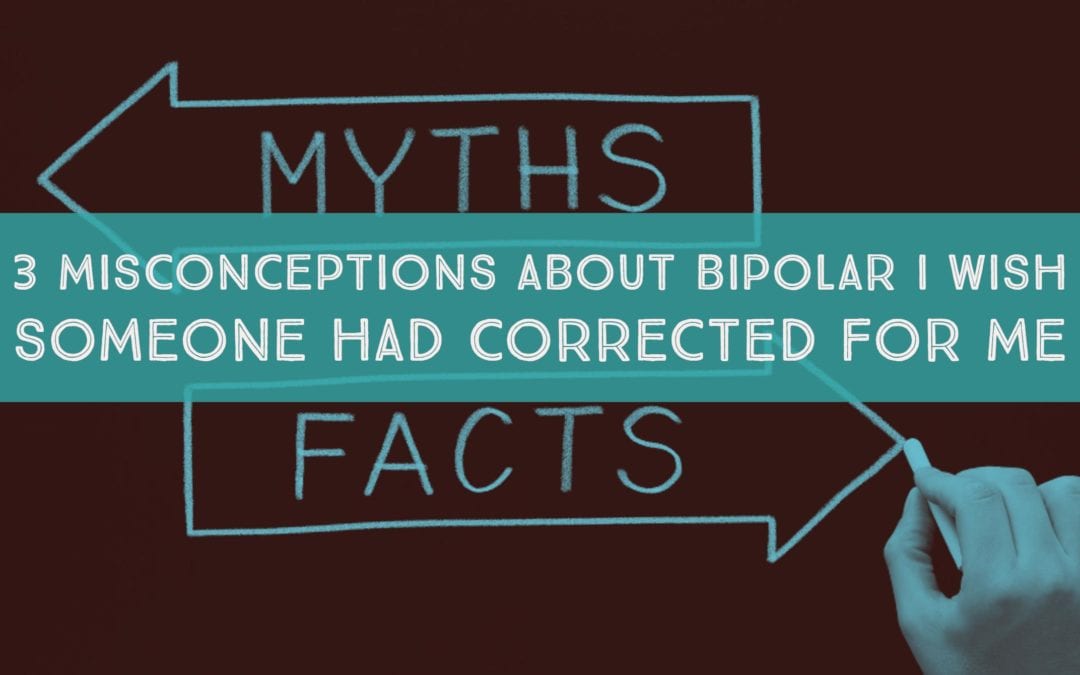Help us win Healthline’s Best Health Blog of the Year! Vote for International Bipolar Foundation here.
I was diagnosed with bipolar type I disorder when I was twenty-three after experiencing nine years of symptoms, a diagnosis of depression, and then a diagnosis of bipolar type II. I consider myself lucky that I was diagnosed at a young age. However, there were some misconceptions I had about bipolar disorder that I wish someone had corrected so I could have gotten help sooner.
1. The highs of bipolar are not always mania
Before I was diagnosed with bipolar I thought that the high parts of bipolar disorder were always manic highs – the extreme highs on the continuum. When I was in my late teens and early twenties while completing my undergraduate degree I suspected I had bipolar disorder (sometimes more strongly than others). However, I was also filled with doubt because although at times my behavior was uncharacteristic, it wasn’t incredibly outlandish. I would stay up for hours writing, drawing, and learning everything that I possibly could. I immersed myself in creative bubbles. I thought I was a genius and that my creativity and intellect would make me famous. Ideas came thick and fast and my mind was very clear and very fast paced. Though I had learned about bipolar when getting my nursing degree, I didn’t know anything about hypomania, only mania. So because I wasn’t doing very obvious manic things, a lot of the time I thought I was being dramatic for thinking I had bipolar.
It wasn’t until a few years later, when my moods had gotten worse, that I learned about the different types of bipolar disorder, and hypomania. While I was waiting for the first appointment with my psychiatrist, my former lecturer leant me Kay Redfield Jamison’s, Touched with Fire. It was this book that made me properly research bipolar disorder, and it came as no surprise when I was diagnosed with bipolar type II a week after reading it. However, within six months I was re-diagnosed with bipolar type I after a manic episode.
It’s really important that people understand not everyone who has bipolar disorder will experience mania. I am a Youth Presenter for an Australian organization, the Black Dog Institute and I deliver presentations about mood disorders to teenagers. I always briefly distinguish between hypomania and mania. If I had known about hypomania during my undergraduate degree, then maybe I wouldn’t have been self-conscious about getting help specifically for bipolar disorder. Maybe I would have gotten help sooner and I would have avoided continually cycling in and out of depressions for those years.
2. Bipolar doesn’t always mean depression and mania
The dreaded mixed-state of depression and mania is hard to understand. Again, this was something I didn’t have any idea about until I was actually experiencing one. Right before I was diagnosed my general practitioner had switched me to a different anti-depressant that put me into a mixed-state. I was still depressed and suicidal, but I was relentlessly agitated, impulsive, irritable and restless. I had racing thoughts but they weren’t wonderful manic racing thoughts, they were depressed racing thoughts that revolved around death and decay. Perhaps the worst part was that I couldn’t sleep to escape what was happening to my body and mind.
Again, luckily I had read Key Redfield Jamison’s books so I had a description of what a mixed-state felt like and when I experienced my first one around the same time, I knew what was happening. However, it didn’t make it any less terrible and the mixing of the depressed mood and manic energy was still confusing and scary. It was also confusing and scary for those around me who thought that bipolar meant you were either happy or sad.
This is another aspect of bipolar I educate people about, especially because mixed-states are the most dangerous states to be in. Additionally, many people who have bipolar experience mixed-states just as frequently as mania, some experience mixed-states more than mania or depression, and some only experience mixed-states instead of mania.
I know that now they’re referred to as mania with mixed features and depression with mixed features, but I still call them mixed-states as they’re completely unlike depression, mania, and hypomania. To me they’re a fourth distinct state.
3. Being diagnosed with a mental illness doesn’t make you a different person
I don’t think I ever thought that being diagnosed with a mental illness changed the person, but I think a lot of people have this misconception. As someone who in recent years has received a diagnosis of bipolar and who has been suicidal, psychotic and hospitalised (amongst a lot of other things), I can tell you I am still the same person I was at 20, 15, 10, or 5. I still have the same interests, ambitions, and dreams. I still have the same high expectations of myself. I still have the same sense of humour. I still think, feel, and love the same way I always have. I am still fundamentally Sally. The wonderful thing that has come out of having bipolar disorder is that it’s made me more motivated, confident, calm, compassionate, understanding, accepting, and grateful. So bipolar disorder may have changed me a little bit, but it has changed me for the better.
Sally also blogs for bp Magazine and The Mighty and has written for Youth Today, upstart and The Change Blog. To read more of her IBPF posts, click here.
The content of the International Bipolar Foundation blogs is for informational purposes only. The content is not intended to be a substitute for professional medical advice, diagnosis, or treatment. Always seek the advice of your physician and never disregard professional medical advice because of something you have read in any IBPF content.


